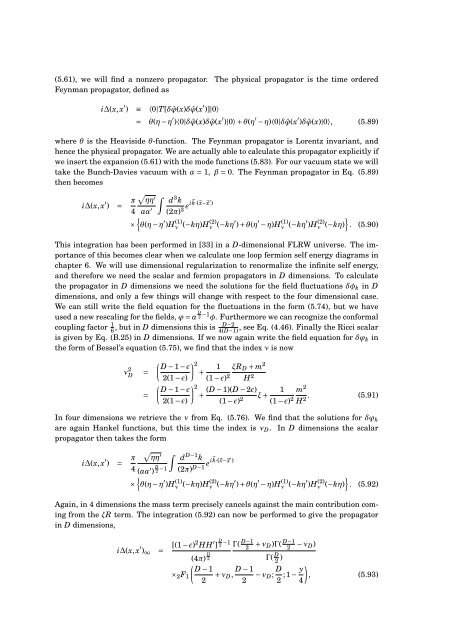Master's Thesis in Theoretical Physics - Universiteit Utrecht
Master's Thesis in Theoretical Physics - Universiteit Utrecht
Master's Thesis in Theoretical Physics - Universiteit Utrecht
Create successful ePaper yourself
Turn your PDF publications into a flip-book with our unique Google optimized e-Paper software.
(5.61), we will f<strong>in</strong>d a nonzero propagator. The physical propagator is the time orderedFeynman propagator, def<strong>in</strong>ed asi∆(x, x ′ ) ≡ 〈0|T[δ ˆϕ(x)δ ˆϕ(x ′ )]|0〉= θ(η − η ′ )〈0|δ ˆϕ(x)δ ˆϕ(x ′ )|0〉 + θ(η ′ − η)〈0|δ ˆϕ(x ′ )δ ˆϕ(x)|0〉, (5.89)where θ is the Heaviside θ-function. The Feynman propagator is Lorentz <strong>in</strong>variant, andhence the physical propagator. We are actually able to calculate this propagator explicitly ifwe <strong>in</strong>sert the expansion (5.61) with the mode functions (5.83). For our vacuum state we willtake the Bunch-Davies vacuum with α = 1, β = 0. The Feynman propagator <strong>in</strong> Eq. (5.89)then becomesi∆(x, x ′ ) = π 4{×√ηη′aa ′ ∫ d 3 k(2π) 3 ei⃗ k·(⃗x−⃗x ′ )θ(η − η ′ )H (1)ν (−kη)H(2) ν (−kη′ ) + θ(η ′ − η)H (1)ν (−kη′ )H (2)ν (−kη) }. (5.90)This <strong>in</strong>tegration has been performed <strong>in</strong> [33] <strong>in</strong> a D-dimensional FLRW universe. The importanceof this becomes clear when we calculate one loop fermion self energy diagrams <strong>in</strong>chapter 6. We will use dimensional regularization to renormalize the <strong>in</strong>f<strong>in</strong>ite self energy,and therefore we need the scalar and fermion propagators <strong>in</strong> D dimensions. To calculatethe propagator <strong>in</strong> D dimensions we need the solutions for the field fluctuations δφ k <strong>in</strong> Ddimensions, and only a few th<strong>in</strong>gs will change with respect to the four dimensional case.We can still write the field equation for the fluctuations <strong>in</strong> the form (5.74), but we haveused a new rescal<strong>in</strong>g for the fields, ϕ = a D 2 −1 φ. Furthermore we can recognize the conformalcoupl<strong>in</strong>g factor 1 6, but <strong>in</strong> D dimensions this isD−24(D−1), see Eq. (4.46). F<strong>in</strong>ally the Ricci scalaris given by Eq. (B.25) <strong>in</strong> D dimensions. If we now aga<strong>in</strong> write the field equation for δϕ k <strong>in</strong>the form of Bessel’s equation (5.75), we f<strong>in</strong>d that the <strong>in</strong>dex ν is nowν 2 D==( ) D − 1 − ɛ 2+2(1 − ɛ)( ) D − 1 − ɛ 2+2(1 − ɛ)1 ξR D + m 2(1 − ɛ) 2 H 2(D − 1)(D − 2ɛ)(1 − ɛ) 2 ξ +1 m 2(1 − ɛ) 2 H 2 . (5.91)In four dimensions we retrieve the ν from Eq. (5.76). We f<strong>in</strong>d that the solutions for δϕ kare aga<strong>in</strong> Hankel functions, but this time the <strong>in</strong>dex is ν D . In D dimensions the scalarpropagator then takes the formi∆(x, x ′ ) = π √ηη′ ∫4 (aa ′ ) D 2{−1×d D−1 k(2π) D−1 ei⃗ k·(⃗x−⃗x ′ )θ(η − η ′ )H (1)ν (−kη)H(2) ν (−kη′ ) + θ(η ′ − η)H (1)ν (−kη′ )H (2)ν (−kη) }. (5.92)Aga<strong>in</strong>, <strong>in</strong> 4 dimensions the mass term precisely cancels aga<strong>in</strong>st the ma<strong>in</strong> contribution com<strong>in</strong>gfrom the ξR term. The <strong>in</strong>tegration (5.92) can now be performed to give the propagator<strong>in</strong> D dimensions,i∆(x, x ′ ) ∞ = [(1 − ɛ)2 HH ′ ] D 2 −1(4π) D 2× 2 F 1( D − 12Γ( D−12 + ν D)Γ( D−12 − ν D)+ ν D , D − 12Γ( D 2 )− ν D ; D 2 ;1 − y 4), (5.93)
















